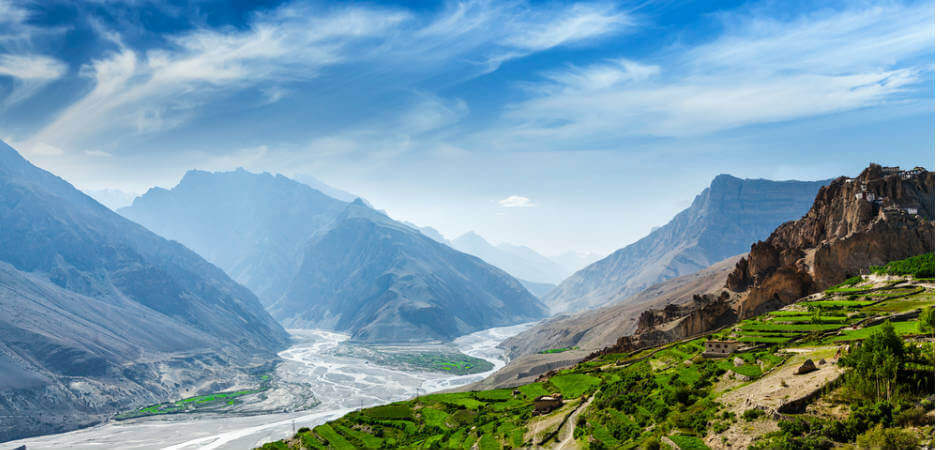In this edition of The Interview, Fair Observer talks to Indian Forest Service officer, Kunal Satyarthi.
Himachal Pradesh, a hill state located in the Western Himalayas, has in recent years become more important in India’s mission to move toward a cleaner future and tackle climate change. Himachal Pradesh has a geographical area of 55,673 square kilometers, 33,000 of which is occupied by forests. While there is awareness of the Indian government’s initiatives to protect forest areas and wildlife across the state, little is known by the general public about how the initiatives are undertaken and what the outcomes have been so far. The science and technology angle is more or less ignored by mainstream Indian media, primarily because of its dry, academic matter.
In this edition of The Interview, Fair Observer talks to Kunal Satyarthi of the Indian Forest Service about the challenges faced by the state government in Himachal Pradesh, the remedial measures being undertaken to counter climate change, and why the outlook for the future is optimistic for one of India’s most resourceful states.
Ankita Mukhopadhyay: Glacial retreat has been observed in 466 glaciers in the Chenab, Parbati and Baspa basins of Himachal Pradesh since 1962. Can you detail some initiatives taken for the protection of the melting glaciers?
Kunal Satyarthi: The most readily available, extensive document monitoring melting glaciers is the Survey of India, which was made in 1960. The Indian government now monitors glaciers every year using methods like remote sensing and tracking from base stations. Two important factors we use to monitor glaciers are area loss and increase in numbers. In the past couple of decades, the area of large glaciers has considerably decreased, but the number of small glaciers has increased. The latter is not a good thing, as it means that larger glaciers are breaking down into smaller glaciers. However, through constant monitoring, we are able to take many remedial measures. For example, the government is now trying to buy drones to estimate area and depth, which is the mass balance ratio of glaciers.
Mukhopadhyay: There have been reports about cloudbursts and torrential rains in Himachal Pradesh that have blocked roads and disrupted power generation. What was the rainfall pattern like in 2017, and what measures are being taken to deal with heavy precipitation?
Satyarthi: If one looks at overall rainfall data, they will see that the volume of rainfall that the state receives has remained the same. However, the number of days of rainfall has gone down, leading to heavy precipitation. The reason for this is definitely climate change, which is affecting not just Himachal Pradesh, but all parts of the world now. Snowfall is also erratic in the state now. This feeds into the problem of stream run-off, which leads to blocked roads. When snowfall happens at the right time, which is December-January, it solidifies and later percolates into the river. However, nowadays snowfall occurs in February-March, and it doesn’t get much time to solidify, eventually leading to stream run-off. The only way to combat this will be to tackle climate change, which will have to occur at a larger level.
Mukhopadhyay: Himachal Pradesh is looking to harness the full potential of hydroelectric power in the state and it started the Sainj project with funding from the Asian Development Bank last year. However, many studies have proven that hydroelectric technology affects glaciers and causes other forms of ecological damage. Has the state government been able to harness hydroelectricity in a sustainable manner?
Satyarthi: Hydroelectricity can be harnessed in Himachal Pradesh as the water is available from glaciers, through run-of-the-river schemes. Hydroelectricity troubles ecology as it generates a massive amount of muck or dirt after a long tunnel is dug to facilitate the project. Damage also occurs as transmission lines cannot go into the river valley, so they have to move up into the mountains, affecting the forest cover. The state government is currently working on a project with the Indian Institute of Science to measure the impact of water flow into hydropower dams. But hydroelectricity is a great source of revenue [Himachal Pradesh has a hydropower potential of around 25,000MW], even though it may not be completely sustainable. This is a trade-off one has to make in order to get electricity in their homes.
The government is taking measures to mitigate the impact to forest cover. For example, there are regulations like compensatory forestation, wherein you have to undertake measures such as afforestation, soil conservation, etc., if you build a hydroelectric power project in a heavily forested area that can lead to loss of forest cover.
Mukhopadhyay: Are there any alternative sources of energy that are coming to the state of Himachal Pradesh?
Satyarthi: Yes, absolutely. The government is looking at alternative forms of electricity generation, under its 100% clean electricity policy, like solar energy, which I believe has a great potential. However, to invest in solar energy, the government has to heavily invest in the plates that generate power, which involves high capital costs. But the government is looking at methods to subsidize these to rein in costs and encourage its adaptation. For example, it is encouraging local communities to install solar panels on the roof of their homes. [This is part of the government of India’s target to generate 100,000MW from solar energy by 2022, of which 40GW will be through the roof-top mode]. An organization called HIMURJA — Himachal Pradesh Government Energy Development Agency — is also working with various stakeholders to reduce costs from solar energy. There are other challenges to generating electricity from solar energy, such as a heavy cloud regime in the state. But the government is not relying on just solar. It is looking for alternative forms of energy generation too, like landfills, optics, etc. Renewable energy does have its hiccups, but it also has its distinct advantages.
Mukhopadhyay: Forest fires have become more frequent in recent years. Why is that, and do these fires present a greater threat for the ecosystem?
Satyarthi: There are three reasons that compound to create forest fires. One is the heavy cover of chir pine trees in the lower Himalayas. Their leaves, when they shed, leave a huge litter on the forest bed, and, being fire-friendly, they instantly catch fire. A second factor is lesser amount of water percolating into the soil because of less and erratic rainfall. This leads to the soil remaining moist and susceptible to catching fire. The third and final factor is a belief among the local people that the grass that comes up after a forest fire is good fodder for their cattle. This leads them to burn down forests, eventually causing a full-fledged forest fire.
Forest fires destroy biodiversity and cause pollution, but unless these three factors are tackled, their frequency won’t decrease. The frequency is also increasing in the months of February-March owing to dryness following scanty rainfall. But we have better tools to predict forest fires now, such as checking air humidity, wind speed, calculating minimum precipitation and checking location through GPS. This helps us to mitigate many possible fires.
Mukhopadhyay: In a notification dated December 2016, the secretary of the Department of Environment, Science & Technology suggested the formation of two committees to examine and enlist endangered species in Himachal Pradesh. Which species are on that that list, and have remedial measures been undertaken for their protection?
Satyarthi: The notification was issued as part of the Biological Diversity Act of 2002, which is a great act as it decentralizes control of biological resource away from the government to the local community. There are three main mandates under it: One, that there should be a management committee at every level that will maintain a people’s diversity register to document all biological resource available in that local body and also all traditional knowledge that is available. Two, the act mandates that if you’re using a biological resource, and you find a prohibited species for use, the use will be regulated. Three, we are trying to make a database of all the traditional knowledge available in this country. For example, there is an Amchi community who were traditionally healers and documented local resources for medicinal use.
This is why the committees were set up in 2016. Such committees will help the government to negotiate with industries and other stakeholders and prevent disasters like the medicinal properties of haldi [turmeric] being patented in the US by two researchers. Now, because of such measures, all traditional knowledge has to be documented in a biodiversity register. After that is done, all companies are liable to share profit with the local parties.
Mukhopadhyay: How is the Department of Environment, Science & Technology tying up with the industry to boost innovation? What are the other measures being taken to encourage research?
Satyarthi: The department has launched a scheme called research and development in Himachal Pradesh, through which we are funding small research projects by Himachalis who are working in the state’s institutions. We have set aside a small amount of money for promoting research in Himachal Pradesh and in that we encourage researchers to file projects on topics like science and technology for rural advancement or solar power. To encourage small research projects, we are also trying to launch a scheme in March or April this year called Vigyan Gram [Science Villages], to make life simpler for people in remote villages. We are also running science popularization programs such as teachers’ training program, where we have a camp for three days where people from IIT Roorkee come and train teachers in math and science. In addition, we have started to encourage debates and discussions around science at state level.
The views expressed in this article are the author’s own and do not necessarily reflect Fair Observer’s editorial policy.
Photo Credit: DR Travel Photo and Video / Shutterstock.com
Support Fair Observer
We rely on your support for our independence, diversity and quality.
For more than 10 years, Fair Observer has been free, fair and independent. No billionaire owns us, no advertisers control us. We are a reader-supported nonprofit. Unlike many other publications, we keep our content free for readers regardless of where they live or whether they can afford to pay. We have no paywalls and no ads.
In the post-truth era of fake news, echo chambers and filter bubbles, we publish a plurality of perspectives from around the world. Anyone can publish with us, but everyone goes through a rigorous editorial process. So, you get fact-checked, well-reasoned content instead of noise.
We publish 2,500+ voices from 90+ countries. We also conduct education and training programs
on subjects ranging from digital media and journalism to writing and critical thinking. This
doesn’t come cheap. Servers, editors, trainers and web developers cost
money.
Please consider supporting us on a regular basis as a recurring donor or a
sustaining member.
Will you support FO’s journalism?
We rely on your support for our independence, diversity and quality.







